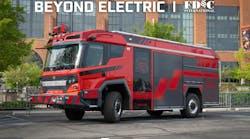1. The roof is extremely hot, especially given the weather conditions. Heat has spread along the red curved line, showing that the fire is traveling above the drop ceiling and is working into the restaurant.
2. The hot windows at the carpet store show heavy heat inside the building. This has not spread completely into the restaurant. The windows are very white, down to about three to four feet above the ground, showing that the heat layer has dropped significantly.
3. Heat columns are pushing from the door on side D. The bright white below the heat columns could be fire hidden within the smoke.
For the TI to be of any use during size-up, it must actually come off the apparatus. In addition, the user must be comfortable carrying and using the TI. To ensure this happens in “real life” incidents, fire departments are advised to take the following steps:
1. The department’s standard operating guidelines (SOGs) must incorporate thermal imager use. The SOG should identify the person assigned the tool and specify that the TI will be taken off the apparatus at every scene. Do not limit use to only fires or to non-EMS runs. In most departments, working structure fires are 10% to 20% of their runs; 70% to 90% are EMS runs. Thermal imagers can help at certain EMS scenes, and regularly carrying the TI reinforces the habit.
2. The TI must be within easy reach of the assigned user. If the company officer is assigned the imager, the TI should be mounted near the officer’s seat. A TI in a compartment or a trunk is used rarely in size-up.
3. Most firefighters realize that how they train is how they will perform. During every training evolution, the assigned person must carry the TI. The user must be comfortable performing all of his or her normal tasks while carrying the imager. Climbing a ladder with a TI hanging from a self-contained breathing apparatus (SCBA) or draped over a shoulder can be frustrating if it is not practiced.
4. Standardize how the TI is carried. Many TIs are supplied with a carrying strap. Test this system and develop the most convenient method of using it that will satisfy the department’s operational needs. Make sure that other fireground tasks can be completed while carrying the imager.
Several drills can develop a user’s proficiency with a thermal imager. A key skill to gain is image interpretation, which requires very frequent use of the TI. Walk around the firehouse looking for odd or out-of-place heat sources. Discuss how and why the image appears as it does. At night, stand outside the firehouse and look at the neighborhood. Practice recognizing construction features; analyze the effects of the sun and weather on the image:
- Are certain parts of a building hotter after a summer day?
- Does a cold rain change the “normal” signature of the building across the street?
Consider the effects of building construction on what is displayed on the imager:
- s heat escaping from the building and what might that suggest about construction?
- Are studs visible or is a masonry wall hiding internal heat due to its mass?
- How is the building’s mass affecting the image?
By examining local structures, users can learn what a “normal” building looks like under non-fire conditions. This can serve as a basis for comparisons at a fire incident.
While sitting around over coffee, TI training can occur as well. Quiz members on the thermal imager SOGs. Brainstorm on different types of scenarios, and when and where a TI can be used to help size-up an incident. How can the TI help size-up these scenes:
- An auto accident?
- A tanker truck rollover?
- A suspected arson?
- A chemical spill at a factory?
Applying the skills and practice in real life is the final exam. Figure 1 is a digital image from an actual structure fire. Figure 2 shows the key points highlighted. Before examining Figure 2, “read” what Figure 1 is showing. Try to determine how advanced the fire is, where it is and where it is going. Decide if this is a building that can be “saved.”
The inherent fire load of a carpet store, along with fire above the drop ceiling, placed fire companies at a disadvantage. Once fire broke through the roof, the incident commander ordered the building evacuated, and the trucks began a defensive fight.
Practice in size-up, as well as early use of the thermal imager, might have gotten the firefighters out of a losing battle earlier and at less risk. Remember, your thermal imager is a tool, not a toy. Use your TI often, wisely and safely
Jonathan Bastian is the thermal imaging training manager at Bullard. He leads the training team, whose primary effort is to educate the fire service on the safe and proper use of thermal imagers. Bastian is certified as a thermal imaging instructor by the Law Enforcement Thermographers’ Association (LETA), the international public safety organization specializing in thermal imager certification and training. He is also a member of the NFPA Technical Committee on Fire Service Training. Educated at Brown University and licensed as a high school teacher in Illinois, Bastian served 12 years on the North Park, IL, Fire Department, including the last three as a captain. As health and safety officer, he led the development and implementation of the department’s rapid intervention team SOG. Bastian is a certified Fire Instructor I and Firefighter III, and he spent 12 years as an EMT-I/D. He has taught classes on thermal imaging, rapid intervention teams, and search and rescue operations. Bastian is happy to answer any questions about thermal imaging; contact him at [email protected].






